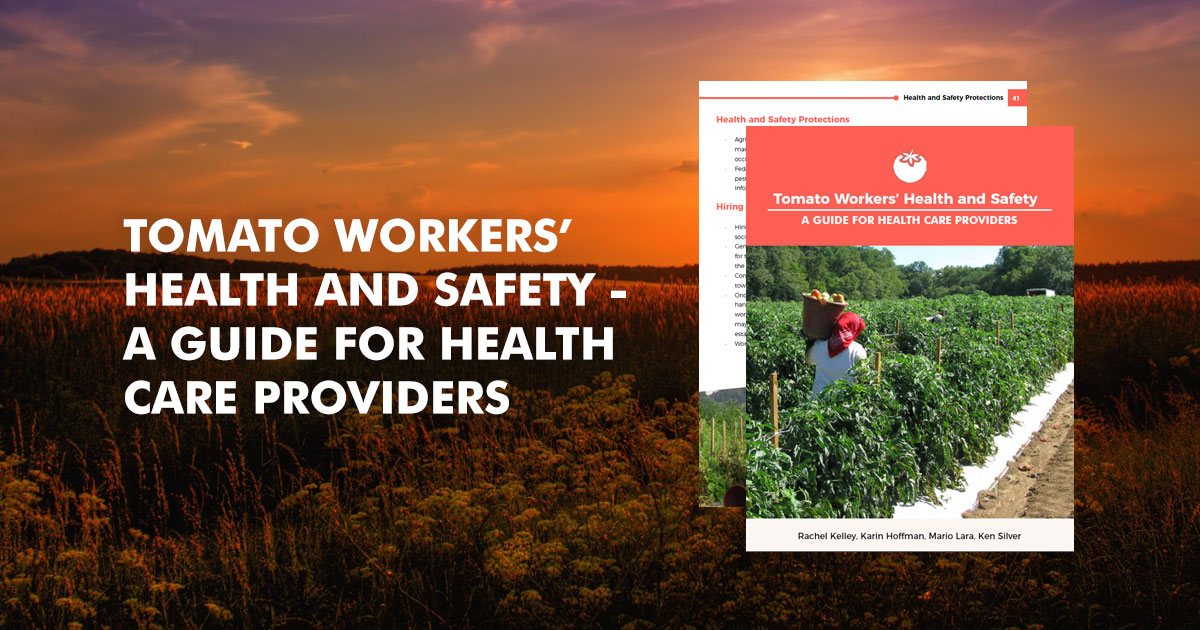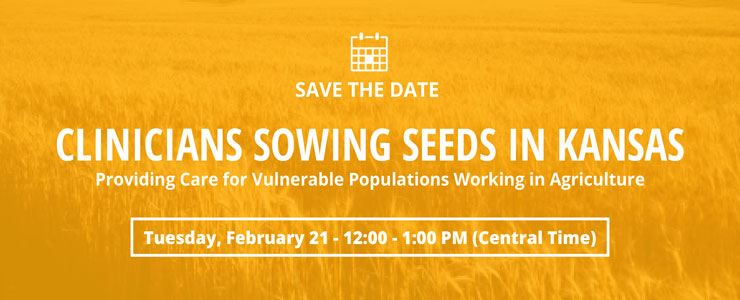- El Que Busca Encuentra Servicios de Salud Comic_Web-Version_11-12-25.pdf (3.9 MB)
- El Que Busca Encuentra Servicios de Salud Comic_Print-Version_11-12-25.pdf (83.74 MB)
- Those Who Seek Find Health Services Comic_Web-Version_11-12-25.pdf (4.76 MB)
- Those Who Seek Find Health Services Comic_Print-Quality_11-12-25.pdf (92.87 MB)
- HIPERTENSION NOVELA version rapida.pdf (2.15 MB)
El humo de los incendios forestales trae consigo un riesgo significativo para la salud y, especialmente, para las poblaciones vulnerables como las de los trabajadores agrícolas, dada la naturaleza de su trabajo y exposición prolongada al aire libre. Esta guía proporciona a los proveedores de servicios de salud y a los trabajadores de salud comunitarios (CHWs por sus siglas en inglés) una visión general de los efectos de la exposición al humo de los incendios forestales; las razones por las que los trabajadores agrícolas son más vulnerables al humo de los incendios forestales; consideraciones específicas para los trabajadores agrícolas y, estrategias prácticas para tomar medidas preventivas.
National STD Curriculum from the University of Washington STD Prevention Training Center. Provides information on different STDs and STIs, which are available for Quick Reference. There is also the option to Self-Study, allowing the user to track progress and receive Continuing Education credit.
From the CDC Morbidity and Mortality Weekly Report, Vol. 70, No. 4, published July 23, 2021.
Summary: "These guidelines for the treatment of persons who have or are at risk for sexually transmitted infections (STIs) were updated by CDC after consultation with professionals knowledgeable in the field of STIs who met in Atlanta, Georgia, June 11–14, 2019. The information in this report updates the 2015 guidelines. These guidelines discuss 1) updated recommendations for treatment of Neisseria gonorrhoeae, Chlamydia trachomatis, and Trichomonas vaginalis; 2) addition of metronidazole to the recommended treatment regimen for pelvic inflammatory disease; 3) alternative treatment options for bacterial vaginosis; 4) management of Mycoplasma genitalium; 5) human papillomavirus vaccine recommendations and counseling messages; 6) expanded risk factors for syphilis testing among pregnant women; 7) one-time testing for hepatitis C infection; 8) evaluation of men who have sex with men after sexual assault; and 9) two-step testing for serologic diagnosis of genital herpes simplex virus. Physicians and other health care providers can use these guidelines to assist in prevention and treatment of STIs."
- STI-Guidelines-2021.pdf (4.24 MB)
CDC framework for assisting clinicians in discussing the sexual health issues of a patient in order to obtain a more complete picture of the patient's overall health. The guide covers the clinical environment, the Five "P"s, and other dialogue with the patient that may arise by the end of the session.
CDC Guidelines, for clinicians, on the use of doxy PEP for the prevention of bacterial STIs. Provides education on prescribing doxy PEP (such as who benefits and for which STIs, potential side effects, etc.), what is still being researched, and a list of additional resources.
Este libro cómico en inglés y español proporciona información básica sobre la salud respiratoria y la contaminación ambiental. Hace un repaso del sistema respiratorio, el material particulado y las fuentes de contaminación del aire. También explica cómo pueden protegerse los trabajadores y sus familias.
- Nadie-sabe-que-respira-hasta-que-la-falta-el-aire_5-22-24_Digital.pdf (3.1 MB)
- COMIC SPANISH PROBLEMAS RESPIRATORIOS FINAL VERSION 22 MAYO 2024.pdf (17.69 MB)
- Nadie-sabe-que-respira_5-22-24_Comic+Logo.pdf (21.94 MB)
- Nadie-sabe-que-respira_Comic_Guia-facilitador.pdf (1.63 MB)
- Clear-the-Air-Protect-Your-Health-From-Bad-Air_5-22-24_Digital.pdf (3.08 MB)
- COMIC RESPIRATORY PROBLEMS FINAL VERSION ENGLISH 22 MAY 2024.pdf (17.59 MB)
- Clear-the-Air_5-22-24_Comic+Logo.pdf (21.78 MB)
- Clear-the-Air-Comic-Book_Facilitators-Guide.pdf (1.48 MB)
- MCN_GuionCapsulasInformativas.docx (26.64 KB)
- La-gripe-aviar-y-tu-seguridad-Guia-para-trabajadores-de-lecherias_2024-5-14.pdf (1.11 MB)
- Avian-Flu-and-Your-Safety-Guidance-for-Dairy-Workers_2024-4-16.pdf (1.11 MB)
- La-gripe-aviar-y-tu-seguridad-Guia-para-trabajadores-de-lecherias_2024-5-14.png (456.92 KB)
- Avian-Flu-and-Your-Safety-Guidance-for-Dairy-Workers_2024-4-16.png (458.15 KB)
Los grandes también se vacunan es una herramienta educativa en forma de cómic para los promotores o educadores de salud que trabajan con la comunidad y que necesitan proporcionar información sobre la vacunación, cuándo y dónde se aplican y cuáles son los síntomas que caracterizan las enfermedades que previenen.
A través de la conversación de unos trabajadores en el campo, este cómic colorido y de fácil comprensión, ayuda a sus lectores a aprender de forma sencilla y natural información sobre la importancia de vacunarse y de reforzar las vacunas en la edad adulta para prevenir enfermedades como hepatitis B, meningitis, varicela, influenza, tétano, difteria, tosferina, sarampión, paperas, rubeola y COVID-19.
- Los-grandes-tambien-se-vacunan_Comic_10-14-25_Digital.pdf (11.08 MB)
- Los-grandes-tambien-se-vacunan_Comic_10-14-25_Imprimir.pdf (50.81 MB)
- Los-grandes-tambien-se-vacunan_Comic_10-14-25_Plantilla.pdf (48.59 MB)
- Adults-Get-Vaccinated-Too_Comic_10-14-25_Digital.pdf (11.13 MB)
- Adults-Get-Vaccinated-Too_Comic_10-14-25_Print.pdf (45.72 MB)
- Adults-Get-Vaccinated-Too_Comic_10-14-25_Template.pdf (45.01 MB)
Covid-19 y nuestra comunidad ¡Más vale prevenir que lamentar! es un material educativo para apoyar la labor de los promotores de salud comunitaria sobre COVID-19 y su prevención. Se complementa con una guía con sugerencias concretas de como usar el rotafolio y enlaces a recursos para quienes quieren profundizar en el tema e investigar si hay algún cambio en la información.
El rotafolio incluye conceptos básicos de COVID-19, la prevención y la vacunación en forma de mensajes claros y sencillos que se apoyan en ilustraciones culturalmente apropiadas para facilitar el proceso de comunicación y transmisión de información a los miembros de la comunidad. Usted puede descargar gratuitamente estos recursos tanto en inglés como en español.
Entre las múltiples obligaciones que tienen los proveedores de salud con sus pacientes, sus familiares y la vida en general, se les olvida colocarse en la lista de prioridades. Este libro cómico dedicado a los proveedores de salud les recuerda lo importante que es cuidarse para poder atender las necesidades de sus pacientes y familiares. También ofrece simples pasos de autocuidado para mejorar el bienestar en general.
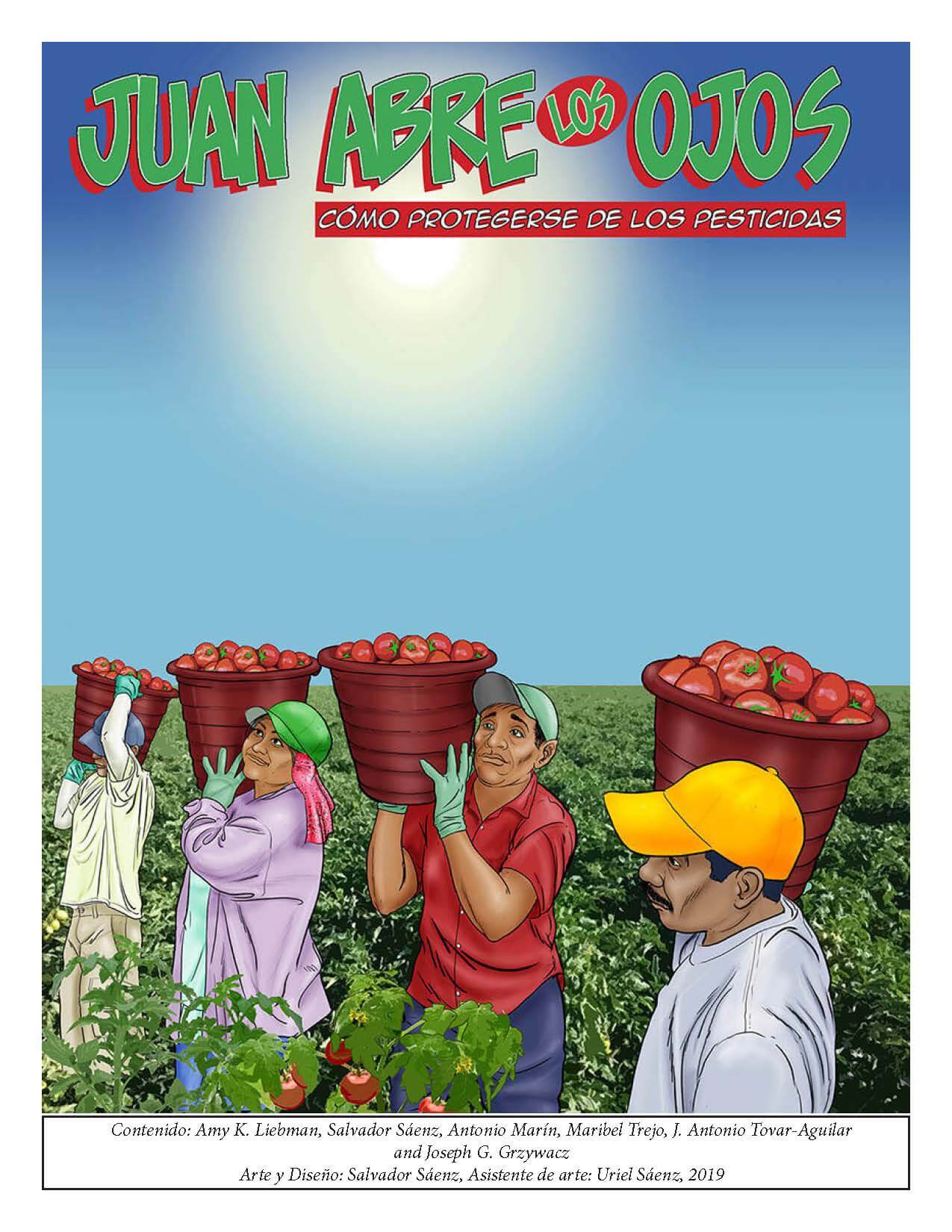
Este libro comic nos cuenta cómo Juan aprendió a protegerse de los pesticidas en el trabajo. Este recurso presenta de una manera muy sencilla y amena cuáles son las fuentes de exposición a los pesticidas, sus efectos en el cuerpo a corto y largo plazo y qué se puede hacer para protegerse de éstos. ¡Es un gran recurso para trabajadores del campo y promotores de salud!
Currículo de entrenamiento sobre las normas de protección al trabajador agrícola y su seguridad sobre los pesticidas -Un currículo cultural y lingüísticamente apropiado con recursos de apoyo para entrenar a los trabajadores sobre las Normas de Protección del Trabajador actualizada. Este currículo fue desarrollado por el Proyecto PISCA de la Universidad Estatal de Florida y la Red de Proveedores de Servicios de Salud para Migrantes.
- WPS PesticidasEnglishFINAL4_2021Website.pptx (33.52 MB)
- WPS PesticidasSpanishFINAL4_2021_Website.pptx (19.67 MB)
- WPSPesticidesFlipChartFINAL_1_23_2020.pdf (8.32 MB)
- WPS Pesticide Facilitator Guide English 2020.pdf (2.03 MB)
- WPS Pesticide Training Facilitator Guide Spanish 2020.pdf (1.99 MB)
- Juan Abre los Ojos como protegerse de los pesticidas (01 14 2020)_0.pdf (7.25 MB)
La diabetes es una condición de salud común pero complicada que enfrentan los trabajadores agrícolas en los Estados Unidos. Para ayudarles a conocer sobre esta enfermedad, Migrant Clinicians Network se asoció con Salvador Sáenz (artista profesional y coloborador) para crear "Mi salud es mi tesoro: una guía para vivir bien con diabetes". Este libro cómico en español explora el tema a través de la historia de un trabajador agrícola llamado Goyo, quien recientemente fue diagnosticado con diabetes. En la historia Goyo entable conversaciones con otros trabajadores agrícolas sobre dieta, ejercicio, enfermedad, y prevención mientras enfrenta los retos particulares de vivir como migrante.
- 2023-8-4_Mi-salud-es-mi-tesoro_Comic_WEB.pdf (4.87 MB)
- 2023-8-4_Mi-salud-es-mi-tesoro_Comic_PRINT_0.pdf (38.74 MB)
- 2023-8-21_Mi-salud-es-mi-tesoro_PuertoRico_Web_0.pdf (5.74 MB)
- 2022-6-13_My-Health-Is-My-Treasure_Comic_WEB_0.pdf (4.97 MB)
- 2022-6-13_My-Health-Is-My-Treasure_Comic_PRINT_0.pdf (38.95 MB)
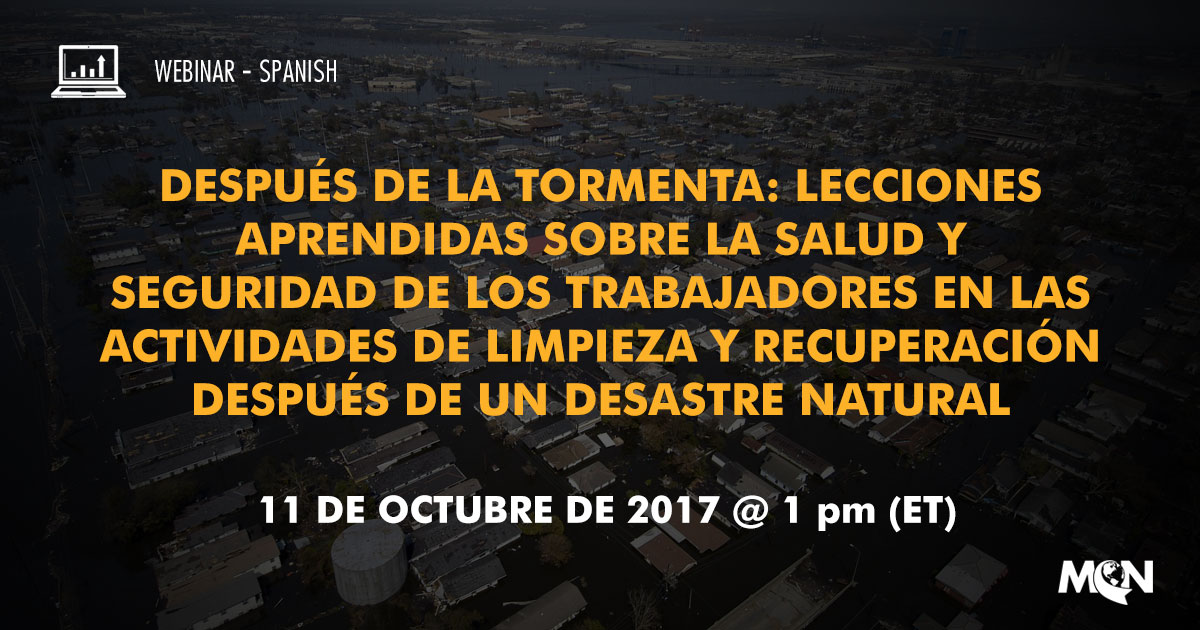
FECHA: 11 de Octubre de 2017 @ 1 PM (ET)
PRESENTADORES:
- Alma R. Galván, MHC, Migrant Clinicians Network
- Richard Rabin, MassCOSH
- Rossana Coto-Batres, MSW, Northeast New York Coalition for Occupational Safety and Health (NENYCOSH)
Crédito de educación continua
Para recibir credito de Trabajador/a de Salud Comunitaria o Educacion de Continua de Enfermera después de ver alguno de estos seminarios usted debe hacer lo siguiente:
- Completar la evaluación participante asociado a cada webinar
- Enviar un correo electrónico con su nombre y apellido indicando que ha completado a malvarado@migrantclinician.org
Descripción
Conforme las familias regresan a sus hogares en Houston, una vez que las inundaciones causadas por los Huracanes Irma y María se van retirando, esto se convierte en una carrera contra el tiempo. Un olor sofocante llena los cuartos de las casas, los charcos permanecen en los pasillos, y el moho se multiplica rápidamente. En cuestión de días, los patios ensopados de los vecinos se convierten en tiraderos de basura, conforme los trabajadores empiezan a quitar de las casas las paredes con moho, los pisos y los cielos destruidos, así como los muebles dañados. En este proceso, los trabajadores y muchos residentes se exponen al agua contaminada con químicos y basura, materiales de construcción peligros y alimañas dañinas. Pero hay otros riesgos adicionales, estructuras inestables y posibles intoxicaciones por monóxido de carbono de los generadores que trabajan incansablemente en espacios con poca ventilación. La exposición a asbestos, sílice y plomo son también peligros comunes para estos trabajadores.
Katrina, Sandy, Harvey, Irma y ahora Maria: son nombres de tormentas que nos indican las diferentes comunidades que terminaron bajo el agua, pero muchas de las historias emanadas de ellas, sobre la limpieza -- y los peligros involucrados-- son las mismas. Con resiliencia y determinación, las comunidades se tratan de reconstruir, pero la reconstrucción necesita una fuerza de trabajo inmediata, lista para este trabajo peligroso y extenuante.
Las operaciones de recuperación después del desastre, limpieza y reconstrucción presentan muchos riesgos y peligros para los trabajadores. Muchos de ellos realizan este trabajo sin el equipo de seguridad o el entrenamiento de mitigación de peligros adecuado.
En la recuperación de una supertormenta, ¿cuáles son las vulnerabilidades que los trabajadores enfrentan y qué significa eso para la seguridad y la salud del trabajador? Las siguientes preguntas surgen para los proveedores y trabajadores de salud comunitarios que cuidan y se preocupan por estos trabajadores: ¿cuáles son los puntos claves que necesitamos entender para poder cuidar de aquellos involucrados en estos esfuerzos de limpieza y reconstrucción? y ¿qué podemos hacer para que ellos mismos prevengan las lesiones y las enfermedades?
Este seminario en línea recupera experiencias obtenidas de desastres naturales anteriores y ofrece recursos que le pueden guiar en su trabajo. Ofreceremos casos reales para ilustrar los peligros y revisaremos formas en que los trabajadores se pueden proteger a sí mismos, incluyendo el entendimiento de sus derechos y responsabilidades.
Objetivos de aprendizaje
- Los participantes identificarán los peligros más comunes y críticos que los trabajadores y residentes encuentras cuando se involucran en la demolicion y reconstruccion despues de un desastre.
- Los participantes articularán las mejores estrategias para educar a los trabajadores y residentes sobre como prevenir lesiones y enfermedades durante las actividades de limpieza y reconstrucción después de huracanes y supertormentas.
- Los participantes enlistarán al menos tres recursos que pueden usar para guiar a los trabajadores y residentes durante la demolición y reconstrucción después de un desastre.
Este proyecto cuenta con el apoyo de la Administración de Recursos y Servicios de Salud (HRSA) del Departamento de Salud y Servicios Humanos de los Estados Unidos bajo el acuerdo de cooperación número U30CS09742, Asistencia Técnica a Centros de Salud Comunitarios y Migrantes y Personas sin Hogar por $ 1,094,709.00 con 0% del total Proyecto NCA financiado con fuentes no federales. Esta información o contenido y las conclusiones son las del autor y no deben ser interpretadas como la posición o política oficial de, ni cualquier endosos deben ser inferidos por HRSA, HHS o el Gobierno de los Estados Unidos.
Offers basic screening questions, common occupations and ailments associated with them, as well as recommended treatment. Also includes sample letters from clinicians to employers for restricted work.
"Coccidioidomycosis or Valley Fever is an infectious disease in parts of the U.S.A. It is caused by inhaling microscopic arthroconidia (also known as arthrospores or spores) of the closely related fungal species Coccidioides immitis and C. posadasii. Areas where Coccidioides is endemic (native and common) include states in the southwestern U.S.A. such as Arizona, California, New Mexico, Nevada, Texas, and Utah and parts of Mexico, Central America and South America."
Safety and Health Practicesfor Nail Salon Workers and a Training Guide for Nail Salon Worker Safety and Health Outreach Program
- Best_Practices_HOPE.pdf (230 KB)
- Trainer_Guide_HOPE.pdf (1.34 MB)
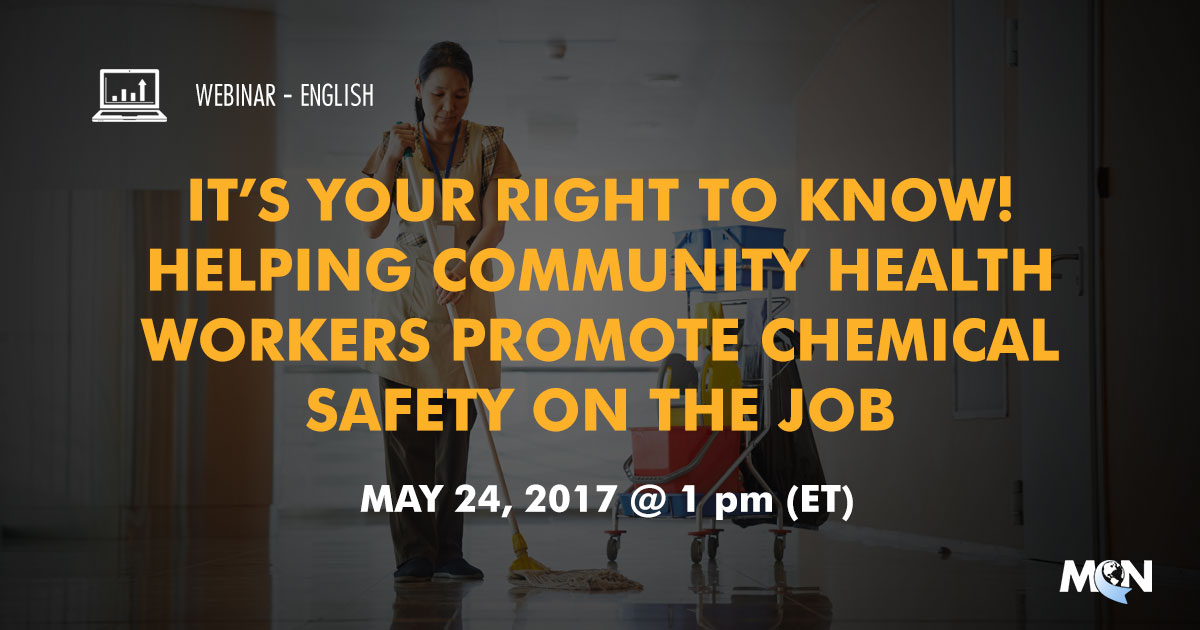
DATE: May 24, 2017, 1 pm (ET)
SPEAKERS: Juliana Simmons, MSPH, CHES
Continuing Education Credit
To receive CME* or CNE credit after viewing this webinar, you must:
- Complete the Participant Evaluation associated with this webinar
- Send an email with your first and last name stating which webinar you completed to contedu@migrantclinician.org
Description
José Navarro was excited for his new career after landing a job in the poultry industry. After five years on the job, 37 year-old Navarro began coughing up blood. He died soon after when his lungs and kidneys failed. His death triggered a federal investigation raising questions about the health risks associated with the use of toxic chemicals in poultry plants.
Millions of workers are exposed to chemicals everyday on the job. All workers have the right to know about the chemicals they work with and community health workers can be an important source of information and support for workers. This workshop will teach community health workers how to explain what happens when someone is exposed to chemicals and how workers can best protect themselves
Learning Objectives
- Recognize how workers become exposed to chemicals and illnesses
- Describe basic safety practices when working around chemicals
- Understand the role of community health workers in identifying and preventing work related illnesses and hazards
This project is supported by the Health Resources and Services Administration (HRSA) of the U.S. Department of Health and Human Services (HHS) under cooperative agreement number U30CS09742, Technical Assistance to Community and Migrant Health Centers and Homeless for $1,094,709.00 with 0% of the total NCA project financed with non-federal sources. This information or content and conclusions are those of the author and should not be construed as the official position or policy of, nor should any endorsements be inferred by HRSA, HHS or the U.S. Government.
Available in English and Spanish!
Created by MCN, medical student Rachel Kelley of UCSF, and collaborators at East Tennessee State University, this guide is intended to be a reference for health care providers who work with people employed in the U.S. tomato industry. It aims to prepare providers with a more detailed understanding of hazards, health issues, and work processes associated with different tomato industry jobs.
This guide draws on published research, experienced health professionals’ advice, and information gathered from interviews and focus groups conducted with 36 tomato workers from diverse backgrounds and 14 community leaders familiar with tomato workers’ health in multiple states. It is important to note that health and safety conditions at any particular farm or company may vary from what is described here. Furthermore, individual workers may experience the same set of conditions differently.
The first section of the guide focuses on health hazards and health conditions commonly encountered in tomato production. The second section consists of detailed descriptions and illustrations of different tomato production tasks. The third section covers “human resources” information and policies that apply to U.S. agricultural workers generally. The appendices contain a Spanish-English glossary, further detail about different types of pesticides, information about agricultural occupational health policies and regulation, and a list of resources and readings.
Una guía para saber cómo reaccionar cuando vea que acosan a alguien. La ilustración artística y el guión son de Uriel Saenz y Alma Galván
Chapter 14: Pesticides Are Poison from the Hesperian.org health guide: A Community Guide to Environmental Health.
DATE: February 21, 2017
SPEAKERS: Ed Zuroweste, MD
Continuing Education Credit
To receive CME* or CNE credit after viewing this webinar, you must:
- Complete the Participant Evaluation associated with this webinar
- Send an email with your first and last name stating which webinar you completed to contedu@migrantclinician.org
Description
Agriculture is also one of the most dangerous industries in the United States. For vulnerable populations working in agriculture, their lack of training, poor safety precautions, regulatory exclusions, lack of health insurance, language barriers, piece-rate pay, immigration status, and geographical and cultural isolation can put these workers at increased risk for occupationally related injuries and illnesses and chronic sequelae. Exposure to pesticides and other contaminants is a particular concern to agricultural workers and their families. This continuing education training will discuss health risks facing immigrant and migrant agricultural workers and their families as a result of their working conditions and environment, with a particular focus on Kansas. It will also highlight best practices and resources for the incorporation of environmental and occupational health in the practice setting, showcasing successful initiatives in primary care settings. Participants will explore the importance of and become familiar with the methods to integrate environmental and occupational health into the practice setting from the clinical perspective as well as consider these issues within the framework of social determinants of health.
Resources
- MCN's Environmental and Occupational Health Program (Migrant Health Center Partnership Description)
- MCN's EOH Screening Tool
- Farmworker Clinicians Manual
- Pesticide Reporting and Workers’ Compensation in Agriculture - Interactive Map
- EPA Recognition and Management of Pesticide Poisonings
- MCN & Farmworker Justice Clinician Guides for Farmworker Health and Safety Regulations
- Patient Education Materials
- Immigrant Dairy Worker Health and Safety
- iCuídate!, a comic book aimed at preventing musculoskeletal injuries among farmworkers
- Pesticide Comic Books
This material was produced, in part, under Assistance Agreement No. X883487601 awarded by the U.S. Environmental Protection Agency. It has not been formally reviewed by EPA. EPA does not endorse any products or commercial services mentioned in this product.
Libro cómic educativo bilingüe sobre cómo prevenir las enfermedades zoonóticas. Desarrollado por MCN en colaboración con la Universidad Estatal de Ohio.
- Trabajos con animales en un rancho_1.pdf (13.31 MB)
- Working with farm animals_1.pdf (13.33 MB)
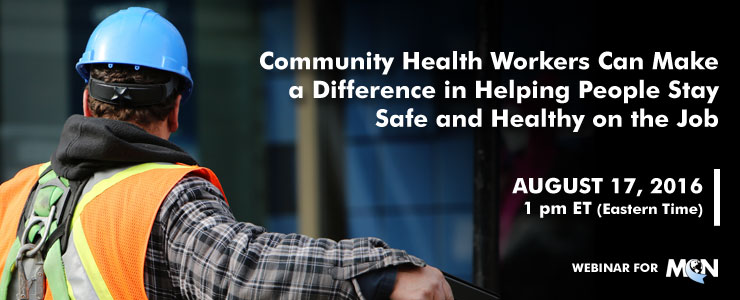
DATE RECORDED: August 17, 2016 at 1 pm ET
PRESENTED BY: Amy Liebman, MPA, MA and Wilson Augustave, member of MCN’s Board of Directors and Senior HIV Case Manager at Finger Lakes Community Health
This material will be produced under grant number SH-27640-15-60-F-48-SH5 from the Occupational Safety and Health Administration, U.S. Department of Labor. It will not necessarily reflect the views or policies of the U.S. Department of Labor, nor does mention of trade names, commercial products, or organizations imply endorsement by the U.S. Government.
- http://migrantclinician.adobeconnect.com/p50hmpih2ti/?OWASP_CSRFTOKEN=3e2b187aeeb1282a41d5df37d8a98c307a7e00006662aca9d5f21dc12aa036c4
- http://www.migrantclinician.org/
- http://workerscomphub.org/
- http://workerscomphub.org/navigating-system
- https://www.osha.gov/workers/index.html
- http://www.coshnetwork.org/know-your-rights
- http://hesperian.org/books-and-resources/
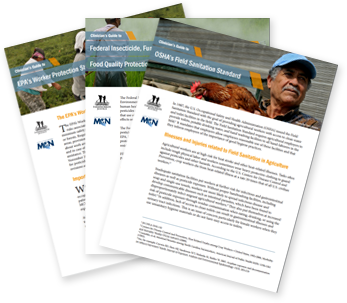
MCN y Farmworker Justice ofrecen estas guías para ayudar a los proveedores de servicios de salud a comprender las regulaciones de salud y seguridad de los trabajadores agrícolas. Información de los Estándares de Saneamiento de la Administración de Seguridad y Salud Ocupacional (OSHA) para los campos; la Ley Federal de Insecticidas, Fungicidas y Rodenticidas (FIFRA) regulado por la Agencia de Protección Ambiental (EPA); la Ley de la Protección de la Calidad de los Alimentos (FQPA) también regulado por el EPA; y el estándar de protección del trabajador (WPS) establecido por el EPA.
- OSHA's Field Sanitation Standard Clinician's Guide.pdf (747.53 KB)
- FIFRA FQPA Clinician's Guide.pdf (287.9 KB)
- WPS Clinician's Guide.pdf (843.35 KB)
Este diccionario ilustrado bilingüe de MCN, "Seguridad en Palabras/ Safety in Words", muestra los peligros que hay en el lugar de trabajo y las mejores prácticas para la salud y la seguridad en la agricultura. Desarrollado con el apoyo del Programa de Subvenciones Susan Harwood de OSHA, este recurso refuerza el vocabulario en inglés de los trabajadores que hablan español lo que ayudará a prevenir lesiones en la agricultura.
